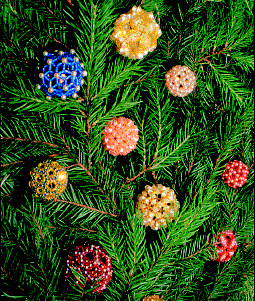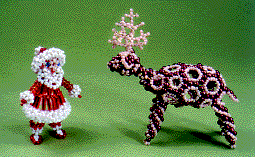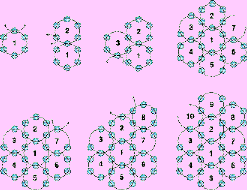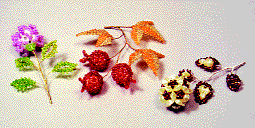Introducing invented by the author of the article the original method of weaving toys beaded — three-dimensional, hollow, without a frame inside.

Who are interested in beads, surely knows how to weave a bead-cube. His description in almost all textbooks on beading. The idea is simple: the cube — beads. Because they are small and round, the product is probably not the cube, and something round, like raspberries.
It turns out that it is similarly possible to make the balls based on other polyhedra, for example on the principle of fullerenes (see “Science and life” № 7, 1992; No. 11, 1993; No. 12, 1999). This principle is used in particular in the manufacture of a soccer ball. These balls are more round and appear larger, more beautiful, more original.
For bead ball, like dice, beads — it's edges (not vertices!).
Here are the most economical and simple weave pattern of a soccer ball. The secret of it is that around each Pentagon — the five hexagons, and each hexagon pentagons and hexagons alternate. If you follow this rule, and ensure on time pick up bead, which should be the common edge (and not to wear new, otherwise are formed two beads instead of one edge), then everything will work itself out. Check it out and you will see it! The figure itself is rounded, where necessary, and time will end.

So, you will need: 90 round beads of the same size (not too small, then it will be easier to see how much has been done and what still needed to be done), wire or fishing line with a length of about 70-80 cm
Braid in a circle counterclockwise two ends of the line. Not to stray from the direction of the weave, podzeplje already work in the beads at one end, and a new dial to another (on different steps, the ends are swapped). In the process, the fishing line passes twice through each bead.
The scheme of weaving “bottom”, the first and the beginning of the second row are shown in the figures. In the description of the positions 1 to 32 correspond to the 32 rings of the ball.

1. Enter on line six beads, lock them in the ring in the first bead. Will “the bottom” of the ball — the lower the ring number 1. The ends of the line make equal length.
2. On the right end of the line type five beads. The left end of the log in the fifth bead. Get a second ring. The ends of the line will change places.
3. The left end hook one bead of the first ring (the one closer), on the right type three beads. Thread the left end through the third bead. Get the third ring. The ends are again swapped.
4. The left end hook one bead of the first ring, on the right — dial the four beads. Thread the left end through the fourth bead (as these actions are repeated in every step, in the future there is no sense each time to remind you which end to put new beads, and how to hook up available).
5. Pick up one bead from the first ring and dial three beads.
6. Pick up one bead from the first ring and dial the four beads.
7. Pick up two beads: the last of the first ring and near the second. Type two beads. The first row is ready.
8. Inset one and type four beads.
9. Inset one and type three beads.
10 and 11. Inset two and type three beads.
12. Inset one and type three beads.
13 and 14. Inset two and type three beads.
15. Inset one and type three beads.
16. Pick up three beads: the last two from the first row (in the sixth and seventh rings) and from the eighth ring of the second row. Enter two new beads. The second series of gossip.
In the third row in each step, except the first and last podzeplje two beads of the previous row. In the first step (ring 17) inset one, and the last (ring 25) three beads: two of the fifteenth and sixteenth rings of the second row and from the seventeenth ring of the third row. New beads in each ring, add: in 17, 18, 19, 21, 22, 24-m — three pieces, and in 20, 23 and 25-m — two.
The fourth row consists of six rings (26 and 31-e).
26. Catch two, type three beads.
27. Catch two, type two beads.
28. Catch three, type two beads.
29. Catch two, type two beads.
30. Catch three, type two beads.
31. Catch three, type one bead.
32. Connect the past six beads at one end of the line. Ball ready.
The description looks pretty scary, but it is actually not difficult. To sum up. First, we made the first hexagon. Around it wove the first row of the six rings at 6, 5, 6, 5, 6, 5 beads; the second row of the nine rings for 6, 5, 6, 6, 5, 6, 6, 5, 6 beads; the third row of the nine rings for 5, 6, 6, 5, 6, 6, 5, 6, 6 beads and the fourth row of the six rings at 6, 5, 6, 5, 6, 5 beads. In the end he closed the remaining beads in the ring.
Use these balls in different products is very interesting. For example, several balls can be done a bunch of berries from someone's head (say, cat). If you take enough large beads, will be released a little Christmas ball. However, Christmas balls circuits can be very different. “Cut” from the soccer ball to the corners or edges or both — here is the new polyhedra. Let us sketch the description of the ball of the soccer ball with the cut off corners and edges.

Instead of every five and hexagon will now be ten - and dvenadtsatikolonnom respectively. Instead of each edge of a soccer ball — square, and instead of the vertices of a hexagon. The weaving begins with a set of 12 beads. Then add five, hook one bead, add three, etc. Around dvenadtsatikolonnom formed face 6, 4, 6, 4, etc. beads. This is the first series. Second row: rings 12, 4, 10, 4, 12, 4, 10, 4, 12, 4, 10, 4 beads, respectively. In the next row, finish the edges and tops of large rings, here again alternating squares and hexagons, etc in that ball 540 beads, and it is already quite suitable for Christmas decorations.
Of course, this way you can do not only balls, but other shapes (if the polyhedron is of a different shape). Opportunity for the imagination here is truly limitless.
Candidate of physics and
mathematical Sciences
E. KRUGOVA.



